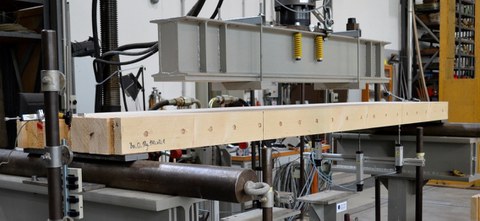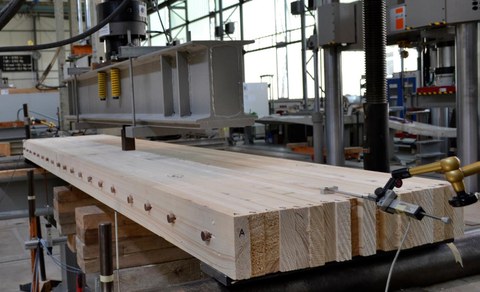Towards Adhesive Free Timber Buildings (AFTB)
Project data
|
Titel | Title |
Report in the annual report 2018
ADHESIVE FREE TIMBER CONSTRUCTIONS WITH LAMINATED BOARDS

4-Punkt-Biegeversuch von klebstofffrei laminierten Holzbrettern
Engineered Wood Products (EWPs) play an important role in the global economy and are increasingly being used for structural applications worldwide due to their enhanced dimensional stability, increased durability, consistent mechanical properties and the availability of large structural sections. Additionally, EWPs have greater environmental benefits compared to those of conventional construction materials (i.e. steel and aluminium). However, there are concerns with the use of adhesives and metallic fasteners which affect their sustainability, recyclability and broader environmental impact. The European Commission has a specific policy with the aim of developing a low-carbon economy by reducing greenhouse gas emissions to 80 % by 2050. One of the strategies aligned with this policy is the development of energy-efficient construction and building materials. Therefore, there is renewed interest in the development and optimisation of novel and sustainable EWPs which can be used as a replacement/alternative to conventional EWPs (i.e. glulam) or other structural materials. This ambition is the subject of an on-going research effort via an EU-funded project entitled Adhesive Free Timber Buildings (AFTB).

Schichtholz mit zusammengedrücktem Buchendübel
In addition to the comparison between the results of solid elements with uncompressed and compressed dowels, the originally planned 4-point bending tests provided the opportunity to evaluate different arrangements. Moreover, 3-point bending tests, with a single load in the middle of the plate, were performed. The dimension of the slab was 3000x600x120 mm, and three samples for each test series were tested.
From the results of this work, it can be deduced that the use of compressed dowels for the connection of slabs as ceiling elements is feasible. The results demonstrated small deviations between the different degrees of compression. It has been concluded that the use of board stacking elements makes better use of timber of lesser quality. The values were significantly higher than those reported by the manufacturers. Furthermore, it could be observed that, even in the case of failure of individual boards, a redirection of the forces took place and the load bearing capacity increased further. This aspect is particularly relevant to safety since the elements presented very ductile behaviour.
